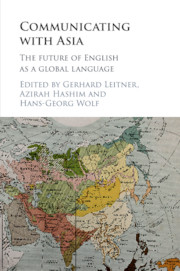Book contents
- Communicating with Asia
- Communicating with Asia
- Copyright page
- Contents
- Figures
- Tables
- Contributors
- Book part
- Communicating with Asia: introduction
- Part I English in selected regional and national habitats with a glance at the role of outward-bound communication needs
- 1 The development of English in Pakistan
- 2 English for Japan: in the cultural context of the East Asian Expanding Circle
- 3 Convergence and divergence of English in Malaysia and Singapore
- 4 Indian English prosody
- 5 Charting the endonormative stabilization of Singapore English
- 6 Arabic in contact with English and Malay in Malaysia
- 7 Preposition stranding and pied-piping in Philippine English: a corpus-based study
- 8 The Americanization of the phonology of Asian Englishes: evidence from Singapore
- 9 Postcolonial and learner Englishes in Southeast Asia: implications for international communication
- Part II Major other languages in Asia, their international status and impact on education
- Part III Wider perspectives
- Bibliography
- Index
8 - The Americanization of the phonology of Asian Englishes: evidence from Singapore
from Part I - English in selected regional and national habitats with a glance at the role of outward-bound communication needs
Published online by Cambridge University Press: 05 January 2016
- Communicating with Asia
- Communicating with Asia
- Copyright page
- Contents
- Figures
- Tables
- Contributors
- Book part
- Communicating with Asia: introduction
- Part I English in selected regional and national habitats with a glance at the role of outward-bound communication needs
- 1 The development of English in Pakistan
- 2 English for Japan: in the cultural context of the East Asian Expanding Circle
- 3 Convergence and divergence of English in Malaysia and Singapore
- 4 Indian English prosody
- 5 Charting the endonormative stabilization of Singapore English
- 6 Arabic in contact with English and Malay in Malaysia
- 7 Preposition stranding and pied-piping in Philippine English: a corpus-based study
- 8 The Americanization of the phonology of Asian Englishes: evidence from Singapore
- 9 Postcolonial and learner Englishes in Southeast Asia: implications for international communication
- Part II Major other languages in Asia, their international status and impact on education
- Part III Wider perspectives
- Bibliography
- Index
Summary
This chapter seeks to find out if the phonology of Singapore English (SgpE) has been Americanized. This chapter will focus on four pronunciation features in SgpE, namely, the postvocalic-r, taps, the pronunciation of the vowel [æ] in dance, and the vowel [eɪ] in tomato. In order to ascertain if there has been a “shift” or change in the phonology of SgpE, speakers of an older group aged forty and above will be compared with a younger group of speakers who are aged between twenty and twenty-five. The informants for the data also consist of speakers of all three major ethnic groups in Singapore – the Chinese, Malay, and Indians, and a comparison will be made between these three groups to see if any particular ethnic variety of SgpE is more susceptible to Americanization. The results show that some American English (AmE) features are not prevalent across all age and ethnic groups. While it is perhaps not surprising that younger speakers display significantly more AmE features than older speakers, it is interesting to note that the speakers of the Chinese ethnic group are the ones producing more AmE phonological features, as compared to the speakers of the other two ethnic groups. The results on the whole suggest that postcolonial Englishes, such as SgpE, adapt their linguistic features with the force of globalization.
- Type
- Chapter
- Information
- Communicating with AsiaThe Future of English as a Global Language, pp. 120 - 134Publisher: Cambridge University PressPrint publication year: 2016
- 7
- Cited by

